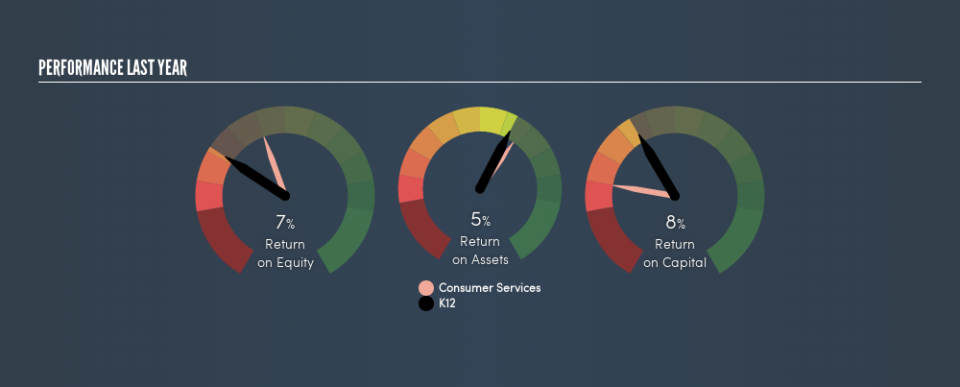Examining K12 Inc.’s (NYSE:LRN) Weak Return On Capital Employed

Today we'll evaluate K12 Inc. (NYSE:LRN) to determine whether it could have potential as an investment idea. In particular, we'll consider its Return On Capital Employed (ROCE), as that can give us insight into how profitably the company is able to employ capital in its business.
Firstly, we'll go over how we calculate ROCE. Next, we'll compare it to others in its industry. And finally, we'll look at how its current liabilities are impacting its ROCE.
What is Return On Capital Employed (ROCE)?
ROCE measures the amount of pre-tax profits a company can generate from the capital employed in its business. All else being equal, a better business will have a higher ROCE. Ultimately, it is a useful but imperfect metric. Author Edwin Whiting says to be careful when comparing the ROCE of different businesses, since 'No two businesses are exactly alike.'
So, How Do We Calculate ROCE?
Analysts use this formula to calculate return on capital employed:
Return on Capital Employed = Earnings Before Interest and Tax (EBIT) ÷ (Total Assets - Current Liabilities)
Or for K12:
0.083 = US$55m ÷ (US$809m - US$149m) (Based on the trailing twelve months to March 2019.)
Therefore, K12 has an ROCE of 8.3%.
See our latest analysis for K12
Is K12's ROCE Good?
One way to assess ROCE is to compare similar companies. Using our data, K12's ROCE appears to be significantly below the 11% average in the Consumer Services industry. This performance could be negative if sustained, as it suggests the business may underperform its industry. Setting aside the industry comparison for now, K12's ROCE is mediocre in absolute terms, considering the risk of investing in stocks versus the safety of a bank account. Investors may wish to consider higher-performing investments.
In our analysis, K12's ROCE appears to be 8.3%, compared to 3 years ago, when its ROCE was 2.4%. This makes us think the business might be improving. You can click on the image below to see (in greater detail) how K12's past growth compares to other companies.
When considering ROCE, bear in mind that it reflects the past and does not necessarily predict the future. ROCE can be deceptive for cyclical businesses, as returns can look incredible in boom times, and terribly low in downturns. This is because ROCE only looks at one year, instead of considering returns across a whole cycle. Since the future is so important for investors, you should check out our free report on analyst forecasts for K12.
K12's Current Liabilities And Their Impact On Its ROCE
Liabilities, such as supplier bills and bank overdrafts, are referred to as current liabilities if they need to be paid within 12 months. Due to the way ROCE is calculated, a high level of current liabilities makes a company look as though it has less capital employed, and thus can (sometimes unfairly) boost the ROCE. To check the impact of this, we calculate if a company has high current liabilities relative to its total assets.
K12 has total assets of US$809m and current liabilities of US$149m. As a result, its current liabilities are equal to approximately 18% of its total assets. This very reasonable level of current liabilities would not boost the ROCE by much.
What We Can Learn From K12's ROCE
With that in mind, we're not overly impressed with K12's ROCE, so it may not be the most appealing prospect. But note: make sure you look for a great company, not just the first idea you come across. So take a peek at this free list of interesting companies with strong recent earnings growth (and a P/E ratio below 20).
For those who like to find winning investments this free list of growing companies with recent insider purchasing, could be just the ticket.
We aim to bring you long-term focused research analysis driven by fundamental data. Note that our analysis may not factor in the latest price-sensitive company announcements or qualitative material.
If you spot an error that warrants correction, please contact the editor at editorial-team@simplywallst.com. This article by Simply Wall St is general in nature. It does not constitute a recommendation to buy or sell any stock, and does not take account of your objectives, or your financial situation. Simply Wall St has no position in the stocks mentioned. Thank you for reading.

